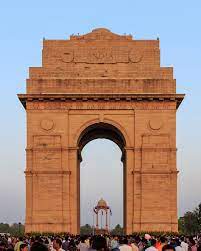India Gate is a prominent monument located in New Delhi, the capital city of India. Here’s a brief overview of its history:
India Gate was originally known as the All India War Memorial and was built to honor the Indian soldiers who sacrificed their lives while serving in the British Indian Army during World War I. The foundation stone for the monument was laid by the Duke of Connaught, Prince Arthur, in 1921, and it was designed by British architect Sir Edwin Lutyens.
The monument was completed in 1931 and was officially inaugurated by the then Viceroy of India, Lord Irwin. The All India War Memorial originally consisted of a red sandstone structure with a height of 42 meters (138 feet), featuring an arched opening at the center and a shallow dome on top.
In 1971, after India gained independence, the Amar Jawan Jyoti (the Flame of the Immortal Soldier) was added to the structure beneath the arch. The eternal flame is a tribute to the Indian soldiers who lost their lives in the Indo-Pak War of 1971.
India Gate has since become an important national symbol and a popular tourist attraction. It serves as a memorial to not only the soldiers who fought in World War I but also the soldiers who sacrificed their lives in subsequent wars, including the Indo-Pak wars and other military conflicts.
Surrounding the India Gate is a vast expanse of landscaped gardens known as the Rajpath. The area around the monument is a popular gathering place for people, especially in the evenings.
India Gate is also the site for the annual Republic Day Parade held on January 26th, where the President of India hoists the national flag and pays homage to the fallen soldiers.
Overall, India Gate stands as a solemn reminder of the sacrifices made by Indian soldiers and serves as a symbol of national pride and unity.







